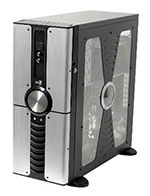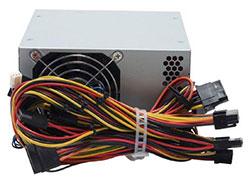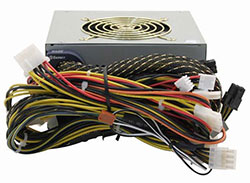Buyer's Guide: Mid-Range to High-End, May 2005
by Jarred Walton on May 23, 2005 5:30 PM EST- Posted in
- Guides
Case and Power Recommendations
Once you have all the internal parts picked out, it's time to find a home for your computer. This is often one of the most difficult decisions to make, as the case is what you'll actually see on a regular basis. If you're not worried about what the case looks like, you can probably get just about any cheap case at your local store. If you want something larger, smaller, flashier, quieter, etc., there is a case to fit your needs. Prices start at about $30 for the cheapest models (forget about the included power supplies!) and go all the way up to hundreds of dollars. We'll give a basic recommendation and a flashier alternative, but if you're looking for a truly exotic case, you're on your own. Well, maybe not quite on your own, but you get the idea.The power supply is a component that often gets overlooked, and for a modern system, we recommend spending a decent amount of money on a high quality power supply. The days of using the included "free" PSU are over for all but the lowest end computers. Sure, that 500W PSU might work well for a few weeks or months, but if you start experiencing system crashes and random instability, a low grade PSU - often with exaggerated performance characteristics - is a prime culprit. Generally speaking, you get what you pay for, so if a recognized name like Antec or Enermax is selling a 375W PSU for $40 and another manufacturer is claiming 500+ Watts for the same price, you should probably be suspicious at best.
Mid-Range Case Recommendation
Case: Antec SLK3000-B
Price: $56 Shipped
For good build quality at a relatively low price, Antec is always a safe bet. We're actually going to pull something of a cop-out and stick with an Antec SLK3000-B as our recommendation. It's nothing special in terms of looks, but it's reasonably quiet, affordable, and well designed. One 120mm fan is provided at the rear of the case with room for a second up front, and rails aid in the installation of hard drives and optical drives. About the only thing that you might find missing is front Firewire and audio ports, but that's not a major concern for most people. The SLK3700-BQE is a slightly more expensive model that does away with the CPU duct and the ventilation holes on the side panel while adding a 350W PSU. While we feel that most Mid-Range and higher PCs should have a better PSU, 350W ought to suffice for many people.
High-End Case Alternative
Case: AeroCool Spiral Galaxies
Price: $108 Shipped
This is definitely not a case for everyone, but we think that some people will really like it, so we're listing it as an option. It's a very large (full tower) case, so if that's not your style, look elsewhere. It does have some innovative features, like a wind tunnel to help keep the CPU cool. The wind tunnel has 120mm fans at the front and rear of the case, ensuring plenty of airflow; it's unfortunate that it doesn't provide air circulation for the GPU area as well, as SLI setups in particular could use some additional ventilation. The motherboard tray is reversed from the standard ATX design - it's on the left panel of the case - but while that's sort of like BTX, the design is still fully ATX compatible. The right panel has a case window with a honeycomb pattern on it (supposedly to reduce EMI), and the case has a door hiding the drive bays that can be locked if necessary. Another plus is the tool-less features for the fans and the expansion slots, and there are even rubber shock absorbers to help reduce noise from vibrations. Besides difference of opinion as to what looks cool, the only real problem is that getting the power cables from your PSU to reach all of the necessary areas can be difficult. If you go with a higher-end PSU, that usually isn't a problem, but you may not be able to determine whether or not a PSU will work until after you've purchased the parts. Overall, it's an interesting and innovative case design at a good price.
Mid-Range Power Supply
PSU: Antec SmartPower 2.0 400W
Price: $66 Shipped
While it is by no means the best power supply that you can find, Antec makes good quality units and provides a standard 3-year warranty for all their products. There are a few cheaper no-name brands that meet the new ATX 2.0 specification, but going with our above statement of prices being a decent indication of quality, we won't recommend a $45 500W ATX 2.0 PSU, as it simply sounds too good to be true. The 400W Antec model meets all the requirements of ATX 2.0, and the price matches up with the features. It has a 24-pin power connection for the motherboard as well as a 4-pin ATX12V adapter, one 6-pin PCIe power connection, two SATA power connections, four 4-pin molex adapters and a 4-pin floppy adapter. It also has dual 80mm fans to keep the internals cool, although that does cause it to create more noise than some other models.
The biggest complaint we have is that all of the cables are bare, meaning that there is no sheathing to make things look tidier. It doesn't really affect performance in any way, but if you have a case window, you might want something more attractive like an OCZ ModStream 450W. That runs about $25 more than the Antec and doesn't include dual 12V rails, but it does have a 24-pin power connector and you only need to plug in the cables that you're using. (The X-Connect Ultra, Antec NeoPower, AeroCool Turbine Power and probably several other PSUs have a similar design.) Fotron Source also makes a 500W PSU with sheathed cables that meets the ATX 2.0 spec, but it doesn't feature detachable cables. It might be a bit cheaper for comparable performance, but it still costs $90.
High-End Power Supply
PSU: Enermax EG565P-VE FMA2.0 SLI 535W
Price: $97 Shipped
For a high-end SLI system, you'll want to make sure that you have a very high quality power supply. The SmartPower 2.0 that we recommended above might be able to run such a setup as long as you didn't want more than one or two hard drives, but you're certainly pushing the limits of the PSU. A high powered graphics card like the 6800GT can easily draw 75W, so two of them running in SLI could use over 150W when gaming. Throw another 100W to the processor, and you've already used a sizeable chunk of the available power. We may have to look into the reliability of various PSUs in a future article, but for now, we would rather err on the side of caution, so we're going to go with power supplies in the 500W and higher range (or at least close to that). There are plenty of power supplies that still meet that requirement, including the 500W Antec SmartPower. However, since we're planning to use this in an SLI setup, what better way to guarantee proper support than to get an SLI certified PSU?
The Enermax Whisper II 2.0 (do you multiply to get 4.0?) has the relatively unique feature of including two 6-pin PCIe power connections. You also get the 24-pin and 12VATX connections for the motherboard, seven 4-pin molex plugs, two 4-pin floppy connections, and four SATA power adapters. The 535W of total power output should be more than sufficient for all but the most extreme configurations. The only real drawbacks are similar to that of the SmartPower. With the exception of the 24-pin cable, the cables aren't sheathed, so they look rather messy. You could sheath them yourself, but that's rather inconvenient.
If you're looking for other alternatives, there are quite a few PSUs that should work fine even with a high-end SLI configuration. Antec has their TruePower 2.0 units, Fotron Source and Seasonic are usually a good bet, and if you liked the alternative case recommendation, there's even a 550W AeroCool PSU that should work well. OCZ offers their ModStream, PowerWhisper and PowerStream units and they should all suffice, though the 600W PowerStream weighs in at a hefty $200+ price. Finally, Silverstone and CoolerMaster also have ATX 2.0 compliant power supplies that compare in price with the others in this list. You could probably get by with a power supply in the 400 to 450W range if you don't add too much other stuff to your system, but when you're talking about spending $700 or more just on graphics cards, we think that it's rather silly to try to save $10 or $20 on the power supply. It's a mistake that can come back to haunt you. It's better to have 150W more power than you need than to come up 25W short.














60 Comments
View All Comments
PotterVilla - Wednesday, December 28, 2005 - link
Hello,I've not been able to find a XFX, MSI, or eVGA 6800GT graphics card at new egg (I'm not really looking to buy, just being wishful) and I also saw that the 6800XT is only $170. The 7800GT is more in your ballpark of $345 a card. Would ether of these cards be an upgrade, and has their price gone down that much ($175) in only about seven months?
Thank you.
jonp - Friday, August 26, 2005 - link
i wonder about the hp 1905fp recommend for the mid-range non-gaming display. there are considerable comments here and elsewhere about the poor analog (d-sub 15 pin) performance ie image quality. the Genesis gm-5321 controller chip is no longer shown on their web site and the datasheets are no longer available as well. (one wonders how much longer the 1905fp will even be available?) the dvi interface might be great, but there are some of us who connect their display through a kvm that only handles analog signals--so dvi performance is of little interest. i think we need a new monitor review and new pick for the non-gaming monitor recommendation. we depend on Anandtech for solid testing and non-subjective analysis to guide us in our quest for the best value. it is clear that we need new help in this area.JarredWalton - Thursday, June 16, 2005 - link
56 - not usually on NVIDIA nF3/4 or Intel chipsets. That's only an issue with secondary SATA controllers (VIA, SiS, Silicon Image, etc.) But still, never hurts to have that $8 part around just in case!mhallang - Wednesday, June 15, 2005 - link
Another reason to get a floppy drive is to install Win XP on a SATA drive. Maybe SP2 is different, and I would bet there's another way around it; but my experience was that I needed a floppy with the SATA drivers during the install process for XP.JarredWalton - Monday, June 13, 2005 - link
54 - Oh, I'd stay far away from XP64 for SLI. Raw doesn't begin to describe it, IMO. Longhorn is when I'll actually consider switching to a 64-bit OS.GreedyBumps - Thursday, June 9, 2005 - link
I built this system with all major components that are in this guide and cannot get SLI to work. Both cards work great individually but when I try to but them both in in SLI mode screen goes black after the black windows loading screen. I have tried all the driver / bios updates for everything I could find and still no dice.One issue could be that I installed Windows x64 professional - maybe some drivers are still too raw.
Also - the SLI jumpers on this DFI Lanparty board are a complete pain. They are tough to pull out and there are 6 of them. When you are trying to get SLI to work it is absolute nightmare to keep switching between SLI and Normal jumper cable settings.
JarredWalton - Wednesday, June 1, 2005 - link
52 - I got the information from Wesley. Basically, there is a higher number of RMA for motherboards and RAM when voltages above 3.3V are used. (Not too surprising, really, as higher V = higher heat.) 3.3V and below are fine, but there is a jumper to allow up to 4.0V. If you use that jumper, it causes problems. That's my understanding. In other words, don't plan on running OCZ VX at 3.7V with no active cooling. :)hgkfahgsa - Wednesday, June 1, 2005 - link
Jarred, could you elaborate on the problems with high voltages with the DFI cards? Is there any chance of the problems being resolved, does 3.3 volts work? etc... Thanks.JarredWalton - Friday, May 27, 2005 - link
50 - I know there are some Turtle Beach cards with S/PDIF in and out connections. M-Audio also has some, i.e. the Delta and Audiophile. Which one you want depends on the use. Most only have optical *OR* coaxial (RCA). I think many of the models with external boxes have both. If you were interested in an expensive, "everything" solution, there's the Audigy 4 Pro, but that's $280 or so, and I can't vouch for the actual quality as a whole.Honestly, I'm not a demanding audio person. If you want more advice on audio, I'm sure there are people in our forums that can provide better advice for "pro level" cards. You may as well ask me for advice on cars while you're at it! (Get something cheap and reliable!) ;-)
devslash - Friday, May 27, 2005 - link
how important is capability of S/PDIF input. i dont see many motherboards that have this on-board.isn't it important/good to have it, so DVD's audio
can be directly fed into the on-board sound system?
can you recommend a good board w/ S/PDIF input?